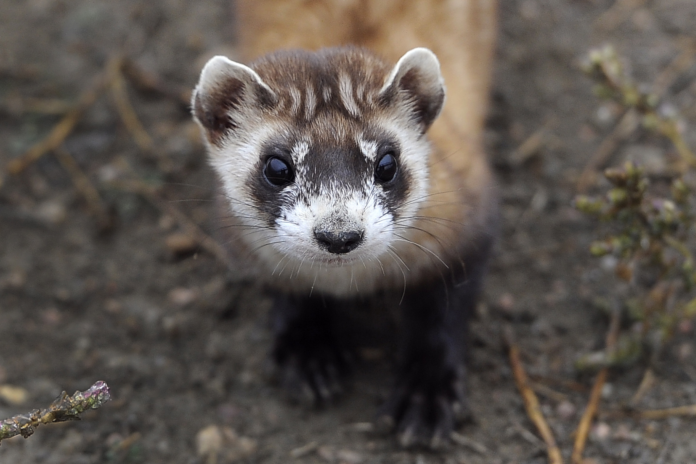As the federal government shutdown drags on into a second week, a critical animal recovery program based in Colorado has ground to a halt, delaying a reintroduction plan that could be crucial to the survival of an endangered species.
Fewer than 1,000 black-footed ferrets remain on the planet, including around 280 captive-bred ones currently being housed at the National Black-Footed Ferret Conservation Center in Carr, Colorado. The U.S. Fish and Wildlife Service had planned to reintroduce them at 15 sites across federal, tribal and private lands this fall, according to the conservation organization Defenders of Wildlife. Instead, the creatures are caught in the political crossfire, with the program at a standstill due to furloughed employees and travel restrictions, the nonprofit wrote in a news release.
“If we can’t get those ferrets on the ground, it would be incredibly unfortunate,” Chamois Andersen, a senior representative with Defenders of Wildlife, told SFGATE in a phone interview.
Advertisement
Article continues below this ad
SFGATE reached out to the Fish and Wildlife Service for information about the reintroduction program but did not receive a response before the time of publication. “Because of the federal government shutdown, www.doi.gov is not being updated and will not be able to respond to inquiries until appropriations are enacted,” the Interior Department website states.
It’s crucial that the ferrets be released during this optimal window, Andersen said, because they need time to acclimatize to the wild prairies of the Great Plains and prepare for the winter months.
“This is the time of year when kits would typically leave their parents and make a living on their own,” she said. “They’ll learn to hunt and survive before winter hits and hopefully den up with one another to bolster the overall population with kits come spring.”
Advertisement
Article continues below this ad
Nonprofits worked to raise $500,000 in emergency funding for this year’s field season in order to monitor wild ferrets and breed a new class of ferrets, with the understanding that they’d be released this year, Andersen added.
BEST OF SFGATE
History | Why a wealthy banker blasted a huge hole in a Bay Area cliff
Local | There’s a mansion hidden directly under the Bay Bridge
Culture | Inside the Bay Area’s cult-like obsession with Beanie Babies
Local | The world’s last lost tourist thought Maine was San Francisco
Get SFGATE’s top stories sent to your inbox by signing up for The Daily newsletter here.
Even if the shutdown ended today and the ferrets could be released, not all of them would survive the winter, and not all of them would give birth to kits in the spring. But the delay in getting the captive ferrets into the wild will likely lead to increased mortality, according to Andersen.
The ferrets’ population, once numbering as high as 1 million, declined throughout the 1900s as prairie dog towns throughout the region were repurposed by humans for farming and ranching. According to the U.S Forest Service, there were two occasions between 1950 and 1980 when officials believed the species had gone extinct.
Advertisement
Article continues below this ad
There were significant efforts to rebuild the population in Badlands National Park’s Conata Basin in the early 2000s, but an outbreak of sylvatic plague in 2009 and 2024 has kept the species from recovering. The plague is often spread through fleas and is an ongoing issue. It also affects the species’ primary food source — prairie dogs — making survival even more of a challenge for the ferrets.
Vaccination programs and flea-control treatments — vital for keeping both prairie dogs and ferrets safe from plague — remain key to the continuation of the species.
“We really need to stay on top of sylvatic plague, and we have the tools to do so with vaccination programs,” Andersen said. “But those programs need staff and travel funds to be successful. This is what it takes to recover an endangered species.”
Advertisement
Article continues below this ad
Recovery of the black-footed ferret has long relied on a web of coordinated efforts — from controlled breeding programs at off-site facilities and zoos throughout the country to carefully timed releases into healthy prairie dog towns.
Wildlife officials also scout out new swaths of open grassland where agriculture and reintroduction can coexist without conflict. Once the ferrets are on the ground, teams use spotlighting and telemetry to track their movements across the prairie, monitoring their progress in real time.
This year has proven especially challenging for the program. Back in February, several employees at the National Black-Footed Ferret Conservation Center were fired, and funding was reduced as cuts from the Department of Government Efficiency, or DOGE, slashed staffing at federal agencies.
Advertisement
Article continues below this ad
If the reintroduction program is stalled for the entirety of the fall, the ferrets that were meant to be released will likely need to stay in captivity — a reality that Andersen calls “unprecedented and unnatural.”
These ferrets are supposed to go off on their own at this point in their lives, Andersen explained, adding that it’s unclear what a longer captivity period would look like or how it would be managed.
“We’re all very nervous about what this could mean for the survival of the species,” she said.
Advertisement
Article continues below this ad




